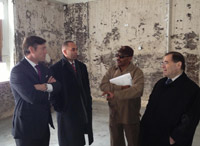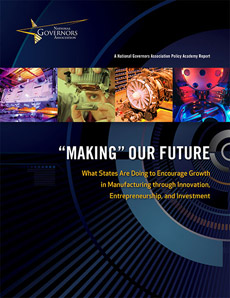
February 2013
|
The mission of the Economic Development Administration (EDA) is to lead the federal economic development agenda by promoting innovation and competitiveness, preparing American regions for growth and success in the worldwide economy. The agency has a competitive grant process and has established the following investment priorities as criteria: collaborative regional innovation, public/private partnerships, national strategic priorities, global competitiveness, environmentally sustainable development, and economically distressed and underserved communities. Q&A: Partnering to Accelerate Advanced Manufacturing in AmericaEDA Partners with National Governors Association to Accelerate Economic and Job Growth
In September 2011, eight states—California, Colorado, Connecticut, Illinois, Kansas, Massachusetts, New York, and Pennsylvania—were selected to participate in the National Governors Association (NGA) Policy Academy, “Making” Our Future: Encouraging Growth in Manufacturing through Innovation, Entrepreneurship, and Investment.” The following month, representatives from these states began participating in a yearlong series of meetings and collaborative exercises designed to foster innovation, rejuvenate manufacturing, create jobs, and grow regional economies. The NGA Policy Academy was funded by the U.S. Economic Development Administration (EDA) and the U.S. Department of Commerce’s National Institute of Standards and Technology Manufacturing Extension Program (NIST MEP). Mary Jo Waits, director of NGA’s Economic, Human Services, and Workforce Division, recently answered some questions about the Policy Academy and its value, both to the eight participating states and to other states that can draw on lessons learned. Q: What makes the Policy Academy unique? A Policy Academy is a process, not an event, facilitated through the NGA Center for Best Practices. What distinguishes it from “one-shot” meetings is that an academy brings together governor-designated teams (representatives from multiple agencies, industry, academia, nonprofits, etc.) and requires a long-term investment of time, energy, and resources in a facilitated process designed to produce tangible outcomes, such as executive orders, changes in administrative practices, and new legislation. Q: Why was manufacturing an important focus for the yearlong Policy Academy? Given all that is happening in manufacturing today—technological advances, a greater focus on tailor-made goods aimed at specific individuals and industry users, and the growing importance of sustainable forms of production—opportunities for the United States to lead are becoming increasingly clear. That leadership, however, will be built on a different breed of policy than the usual formula of enticing global public companies to build plants in this country. Instead, it will be built through a combination of worker education, business innovation, and public- and private-sector entrepreneurship that allows the United States to take the lead in shaping the way manufacturing addresses complex global problems, such as needs for energy, water, food, health, security, and public infrastructure. The work of the states that participated in the NGA Policy Academy is of particular relevance because together they represent 30 percent of total U.S. manufacturing gross domestic product, one-third of U.S. manufacturing jobs, and more than 25 percent of U.S. exports of manufactured goods. And as an eight-state cohort working on similar priorities, they were able to scale up efforts and generate effects that were greater than what could have been done by a single state working alone. Q: What are some of the best practices and successes? As a result of the NGA Policy Academy, the participating states established new programs, such as Connecticut's innovation voucher program, which is providing $800,000 to help connect small and medium-sized businesses to partners and to universities to encourage them to take up regular research and development (R&D) and innovation activities. They also redesigned organizations or created entirely new ones, such as the Colorado Advanced Manufacturing Alliance and the Pennsylvania Governor's Manufacturing Advisory Council, to ensure a consistent industry voice about the issues and policy priorities and to seed a strong connection among manufacturers, suppliers, financiers, academic research centers and universities, and key government agencies. New legislation was passed, such as California's measure to renew and extend the community college initiative that funds manufacturing and other regional industry workforce partnerships, or Connecticut's establishment of a bipartisan legislative advanced manufacturing caucus to identify top issues for legislative action in 2013. Finally, some states secured funding allocations for their manufacturing priorities, such as $1 million for the Massachusetts Advanced Manufacturing Futures Fund, for initiatives across five high-priority areas. Q: What are some best practice lessons offered for other states that didn't participate in the Policy Academy? Other states will likely be interested in the optimistic vision and associated policy steps taken by all eight states to encourage growth in manufacturing through innovation, entrepreneurship, and investment. They may also benefit from knowing that these states did not see their work as saving manufacturing. Rather, they saw it as creating the best location for the development of new technologies that radically improve production processes or that can be transformed into innovative new products. The participants recognized a big missed opportunity with small and medium-sized companies (SMEs), thus emphasizing better support of startups and SMEs. States are working to encourage SMEs to take up regular R&D and innovation activities, thereby enlarging their R&D base and their opportunities for growth through innovation and global exports. Their efforts include programs to increase universities' ability to cooperate with SMEs (and overcome companies' reluctance to approach and work with research organizations); programs to get people into apprenticeships, internships, and education programs designed to lead to full-time jobs with small and medium-sized manufacturers; and programs to mentor SMEs in working more successfully as suppliers to large companies. Another lesson is that crucial voids remain to be filled, sometimes because the right services for manufacturers did not exist, and sometimes because the needed services lacked the scale and commitment for success. Reinforcement of this message came as the participating states studied what other states and nations were doing to support their industries. Some states are engaged in big collaborations, such as the Automotive Manufacturing Technical Collaborative (AMTEC), which involves 30 community colleges and 34 auto-related plants in 12 states in a new kind of public-private partnership for training and retraining workers. In Germany, organizations such as the Fraunhofer Institutes partner with companies to turn advanced technologies into production processes and commercial products. Yet another lesson is that participants recognized that an intermediary valued by all parties (particularly industry) is crucial not only for developing an effective policy framework, but also for sustaining broad support for advanced manufacturing as a high priority. The Colorado Advanced Manufacturing Alliance and the Massachusetts Advanced Manufacturing Collaborative and Advanced Manufacturing Futures Fund illustrate the deliberate and strategic play states are making to create new public-private partnerships that the community values. Finally, participants understood that they must “just get started” and secure some early achievements and momentum that make a difference to manufacturers. For Colorado, that meant launching Colorado Advanced Manufacturing Alliance—quickly and with private sector funding. For Connecticut, it meant the innovation voucher program. For New York, it meant conducting “Solutions Fairs,” half-day forums in each of 10 regions to bring the state's technology resources to individual businesses; for Illinois, it meant the Open Innovation Network, a partnership to connect industry to research institutions, and research institutions to one another. For Kansas, it meant the Mid-America Manufacturing Technology Center, a Department of Commerce affiliate, implementing a partnership plan and an information/collaboration portal as a centralized reference point for manufacturers. Q: What is the value of this collaboration between the NGA, EDA, and NIST MEP? During the Policy Academy, NGA staff and other experts from EDA, NIST, and State Science and Technology Institute (SSTI) provided workshops, dedicated technical assistance, and information and reports that helped each state achieve its own policy objectives. The Policy Academy meetings, webinars, and other technical assistance exposed the state teams to new models and ideas from across the country and around the world. They have taken these models and created new organizations and programs: Connecticut designed an innovation voucher program based on those implemented in Austria, Holland, and Germany. Colorado is replicating Virginia's model for engaging industry in R&D and workforce development through its Commonwealth Center for Advanced Manufacturing. The process also provided strong incentives for organizations within each state to assemble existing federal, state and local resources and finally collaborate on things that had been talked about for years. In New York, the Policy Academy led to an unprecedented meeting of all the state's Centers for Advanced Technology, Centers of Excellence, and Regional Technology Development Centers. This was followed by the launch of an interactive portal to encourage better collaboration among resource providers. By working together as a cohort, the eight states had the sense that the interest in manufacturing was broader than their state. They faced many of the same challenges and began developing similar solutions. Peer-to-peer learning was one of the most important parts of the process … as was the peer pressure! SPOTLIGHTU.S. Department of Commerce and National Governors Association Release Manufacturing Report
Click here to read press release. REPORT EXCERPTS:
|
 |
Deputy Assistant Secretary Matt Erskine in |
On January 30, EDA Deputy Assistant Secretary Matt Erskine, along with Rep. Jerrold Nadler and Rep. Hakeem Jeffries toured disaster sites in Coney Island, New York, and met with businesses affected by Hurricane Sandy. They were joined by Rep. Gregory Meeks, Queens Borough President Helen Marshall, and other state and local officials in a tour of the Madelaine Chocolate Company in Far Rockaway, Queens. Madelaine’s, in business for more than 60 years, is a family business that employed 450 people before the Hurricane Sandy hit, and is seeking assistance to help reopen for business.
Erskine was in New Jersey the day before, meeting with state and federal officials and representatives from the business community regarding recovery efforts and EDA's involvement.
EDA plays a critical role in the National Disaster Recovery Framework (NDRF) as the coordinating agency for the Economic Recovery Support Function, facilitating recovery activities—such as leveraging existing resources and authorities—to make a positive impact for communities affected by disasters.
At the request of Federal Emergency Management Agency, EDA has been working with federal partners to lead teams of EDA staff to implement the Economic Recovery Support Function in New York and New Jersey in the wake of hurricane Sandy. These teams are helping state and city officials and local communities identify and assess long-term economic impacts and explore immediate and short-term actions to expedite recovery.
EDA can also assist disaster-impacted communities address long-term disaster relief and recovery needs through competitive grants to eligible applicants. EDA’s disaster recovery activities generally fall within three categories: strategic planning and technical assistance; infrastructure design and development; and capital for alternative financing.
|
|
||||
In This IssueUPDATE: EDA Economic InitiativesObama Administration’s Make it in America Challenge: Federal Funding Opportunity to be Launched Soon Interagency Initiative Seeks to Build Capacity, Attract Investment, and Create Jobs in Communities Across the Nation In September 2012, the Obama Administration announced the Make it in America Challenge, a multi-agency initiative to accelerate the trend of increasing investment in the U.S., especially insourcing, where companies are bringing jobs back and making additional investments in America. The competition is being funded by the U.S. Department of Commerce’s Economic Development Administration and National Institute of Standards and Technology Manufacturing Extension Partnership; the U.S. Department of Labor's Employment and Training Administration; and the Delta Regional Authority. The Make it in America Challenge is part of the Obama Administration’s efforts to encourage companies—large and small, foreign and domestic, manufacturers and services providers—to increase investment in the United States. Fourth Round of i6 Challenge to be Announced Soon: Advancing Entrepreneurship and the Innovation EconomyThe i6 Challenge is a multi-agency competition led by EDA’s Office of Innovation and Entrepreneurship to encourage and reward innovative, groundbreaking ideas that accelerate technology commercialization, new venture formation, job creation, and economic growth across the United States. The goal is to promote innovation-based, high-growth entrepreneurship in pursuit of job creation and economic growth. Cluster Mapping Project: Strengthening Economic EcosystemsThe U.S. Cluster Mapping Project is a collaboration between EDA and the Institute for Strategy and Competitiveness at Harvard Business School. The goal is to help build an environment where the private sector can flourish and create connections that will bring together vibrant regional economic ecosystems. Your feedback is requested. EDA 2012 Accomplishments
|


 “The Obama administration is committed to supporting American businesses and workers in advanced manufacturing, which will help create jobs and strengthen our economy while boosting our global competitiveness,” said Acting U.S. Commerce Secretary Rebecca Blank. “The Commerce Department is proud to have partnered with the National Governors Association to produce a report that will undoubtedly prove valuable in helping our nation’s governors grow their local economies.”
“The Obama administration is committed to supporting American businesses and workers in advanced manufacturing, which will help create jobs and strengthen our economy while boosting our global competitiveness,” said Acting U.S. Commerce Secretary Rebecca Blank. “The Commerce Department is proud to have partnered with the National Governors Association to produce a report that will undoubtedly prove valuable in helping our nation’s governors grow their local economies.”
